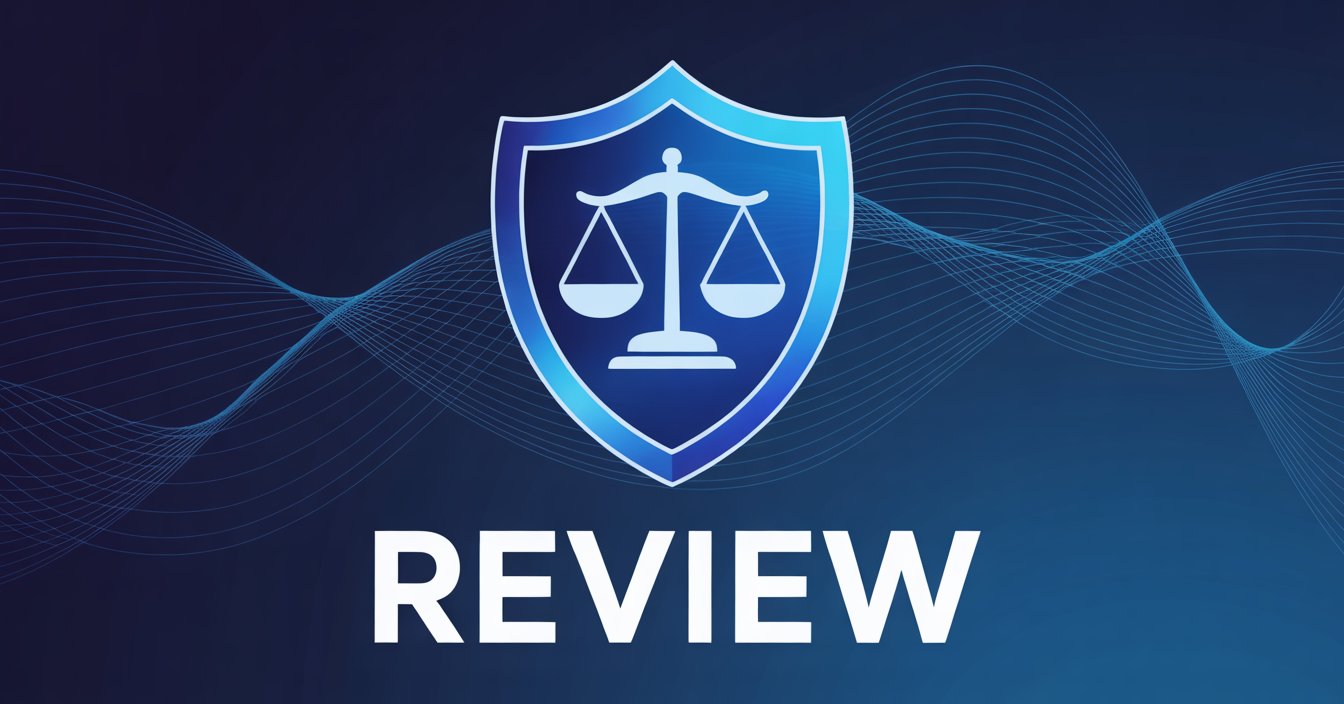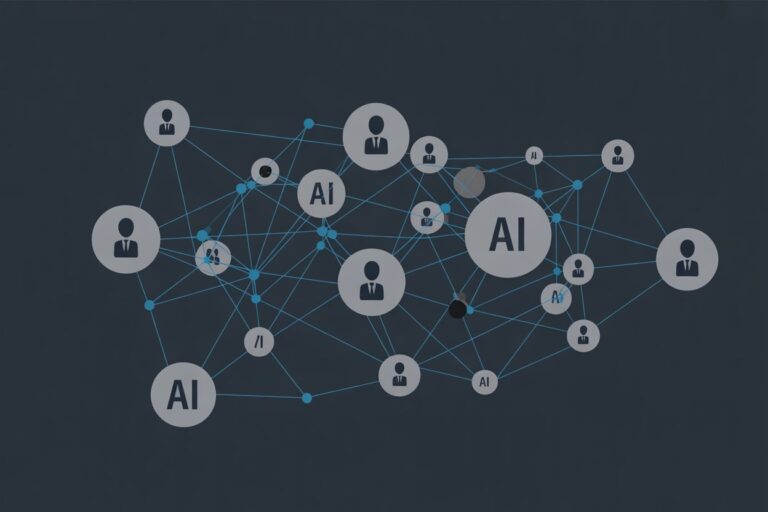ProPlaintiff.ai Review: How It Measured Up Against My Custom Legal GPT
This ProPlaintiff.ai review is based on my subscribing to and using it for nearly two full days. My use included creating a mock client with mock medical records. I also spent 30 minutes on a demo call with ProPlaintiff.ai co-founder and attorney Kristopher Rezagholi
ProPlaintiff is AI software for injury lawyers. It focuses on a handful of legal tasks which include medical summaries, demand letters, pleadings and so on. Not only can it draft pretty much any document or memo or letter an injury lawyer would need to draft, it also serves as full-blown personal injury case management software.
Video Walkthrough
Much of it is done in the drafting screen, which is called the “Paralegal” area. It looks as follows:
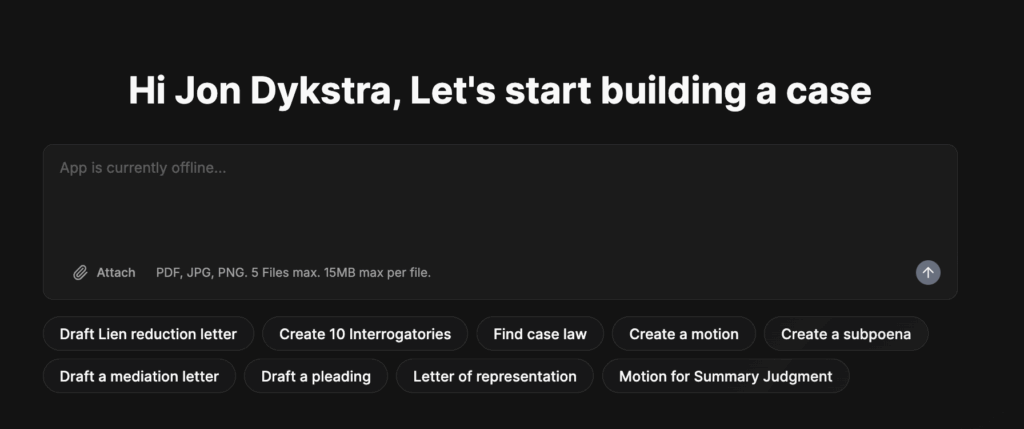
There are dedicated prompt areas for Demand Letters and Medical Summaries.
Initial Thoughts Upon Accessing the Software
I really like how ProPlaintiff is set up. It’s dead simple. Is very user-friendly. Anyone can figure out how to use in under five minutes. UX is excellent. This is how software should be designed. That said, it helps that ProPlaintiff focuses on a single practice area – personal injury law.
Adding Cases to the System
There are two ways to create cases: manually or upload intake forms and let AI create it. I went with the AI method. Unfortunately, the only file type it accepts is PDF. It should offer more options.
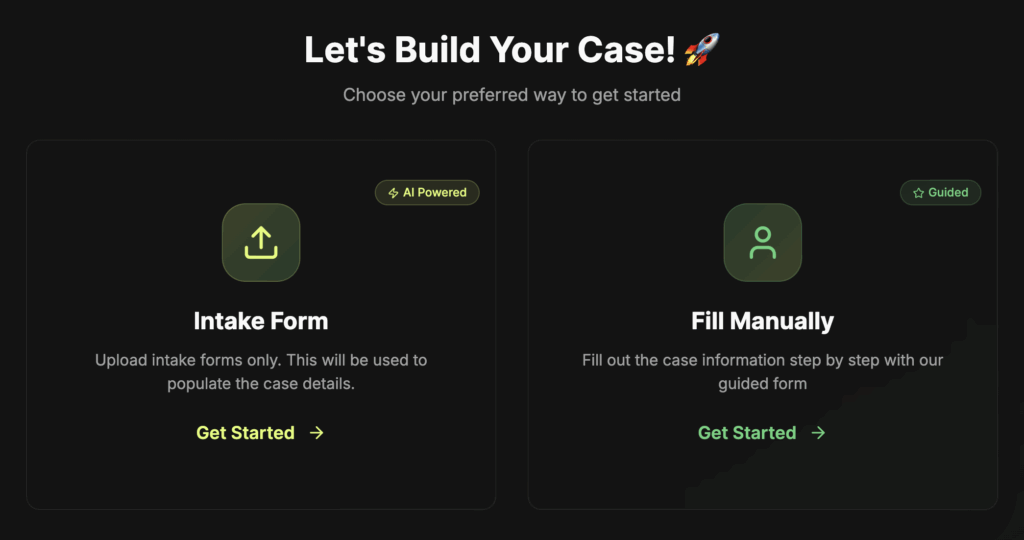
I have a mock injury case scenario. It’s detailed. I simply uploaded the entire PDF for intake and case set up trusting that the AI would extract necessary details for creating the case.
=> Read the full mock injury case scenario here.
I also uploaded while creating the case all medical records and expert reports (mock versions).
Once case details are added and a case is created, here’s what it puts together as a case overview screen:
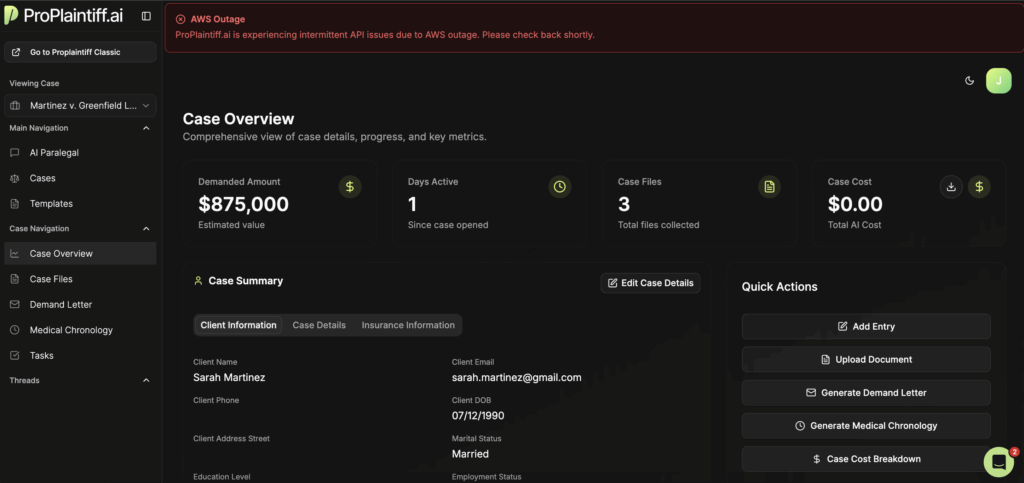
FYI, the $875,000 Demanded Amount was added because that’s the amount in my mock case summary.
How did using the AI intake go?
Excellent. It extracted the correct information to create the case file in the system. Very, very cool.
Here’s a screenshot of the key info it was able to extract from my MOCK injury file.
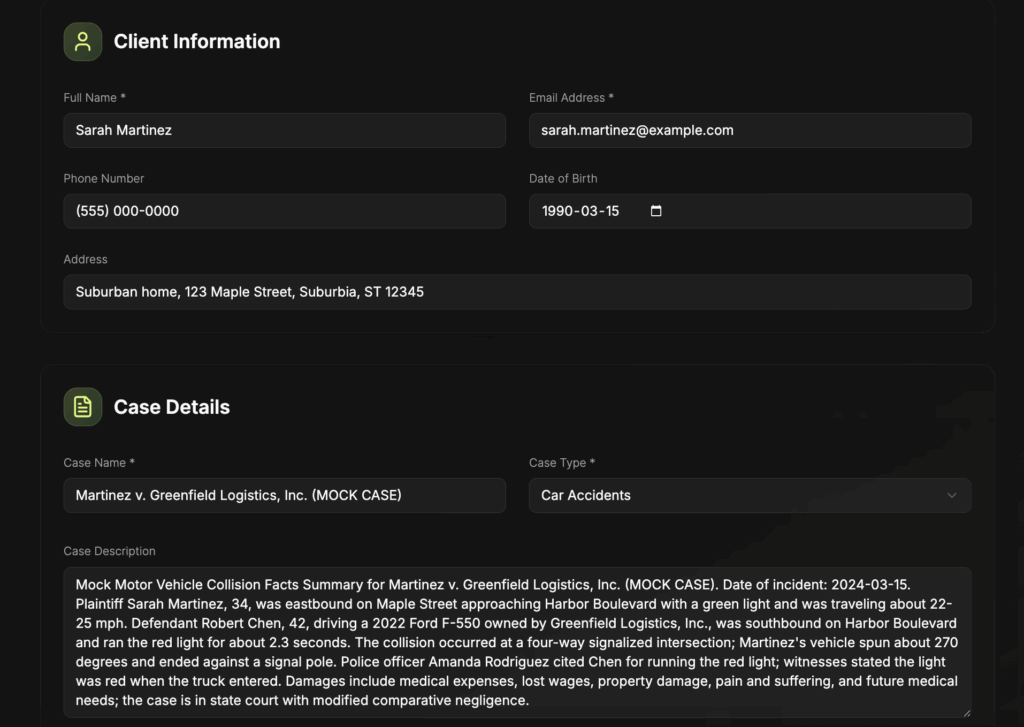
Importing and letting the AI create the case was fantastic. With proper intake processes, opening a new case in ProPlaintiff is a breeze.
Creating Tasks
Once a case is created, you can go in and create a set of tasks. Here’s the task input screen:
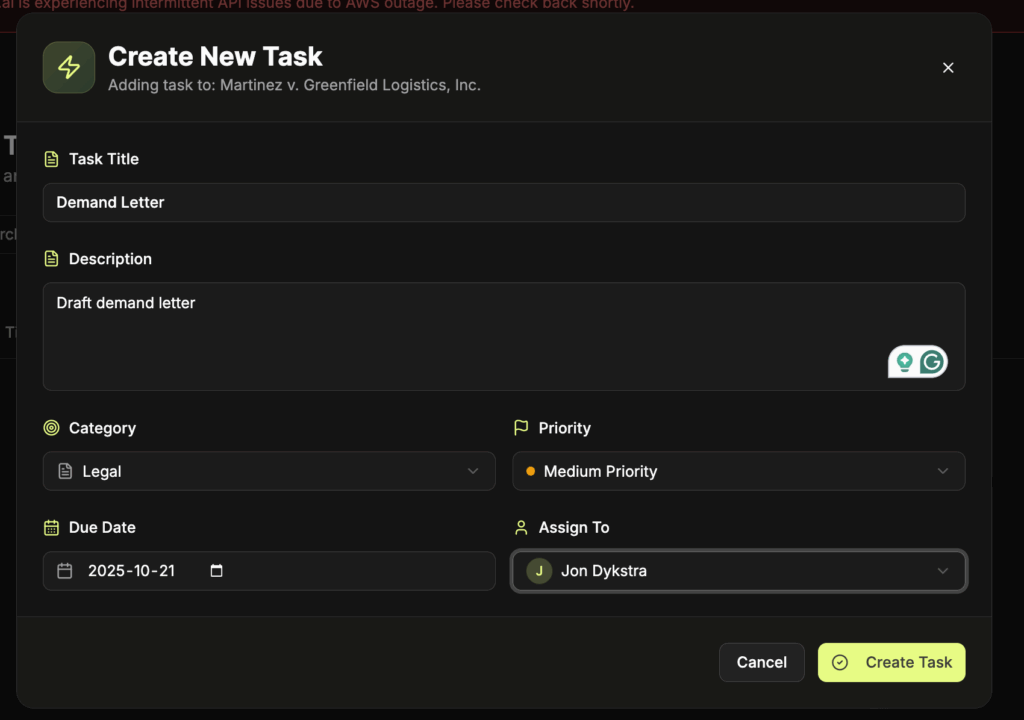
I like that it’s pretty simple but at the same time, entering 20 tasks would take a few minutes.
Customer Support
It’s decent. Like most software these days, the first line of annoyance is dealing with an AI chatbot. While I’m pro AI in many things, AI chatbots annoy the heck out of me. It’s a huge gamble whether it will solve the problem. When it doesn’t, which is often, it takes forever to resolve. Let’s just say ProPlaintiff customer support falls within the acceptable range; it’s neither stellar nor deplorable.
That said, ProPlaintiff is very reasonably priced compared to other AI legaltech software out there. Fully human support means a higher cost.
Demand Letter Drafting
The first operation I ran was generating a Demand Letter. It took 12 minutes to generate the full Demand Letter (as opposed to the Mini Demand Letter option).
Here are the settings I chose:
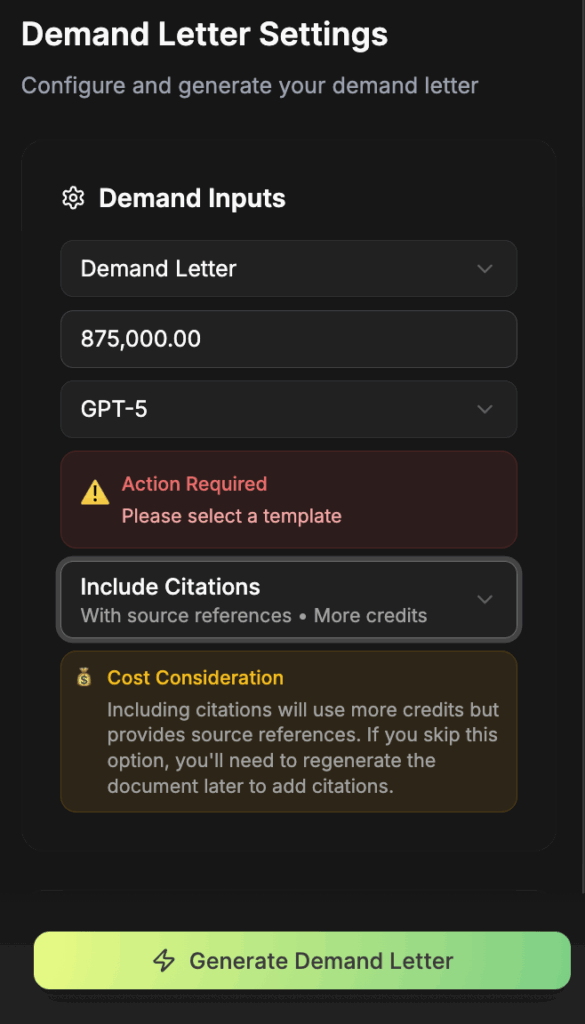
One feature I like is that the demand letter creation runs silently in the backend. While it’s generating, you can hop around the platform handling other tasks.
Generated Demand Letter Draft
The generated Demand Letter sits inside an editor which is great. You can edit it directly in the software and blast it off via email and/or snail mail straight away. The letter is automatically placed in the proper case file.
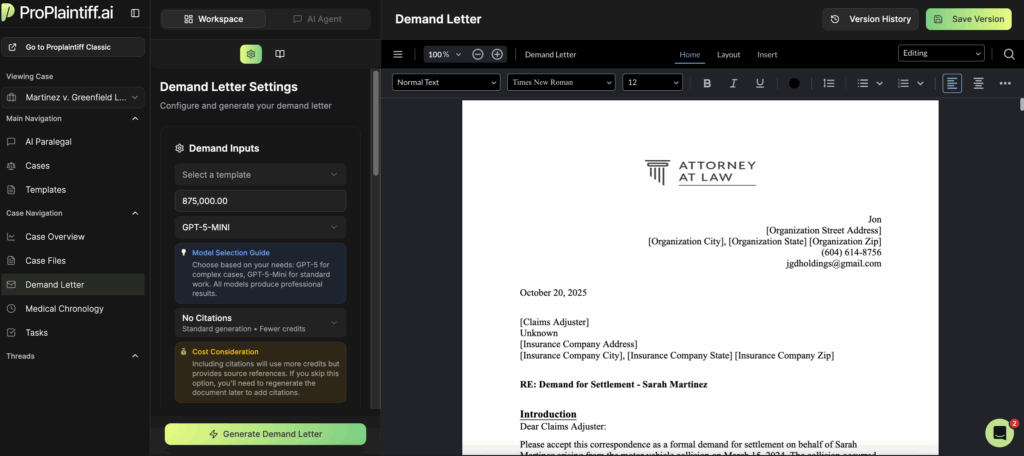
=> ProPlaintiff’s Demand Letter (I made no edits)
Medical Summaries
Medical summaries are at the heart of what ProPlaintiff does. I uploaded my mock 120 page medical records ChatGPT generated for me based on the mock car accident summary I created. I also uploaded all expert reports which were also generated by ChatGPT based on the medical records. FYI, the medical reports are pretty thin but they get the point across.
Here’s the screenshot for creating medical summaries:
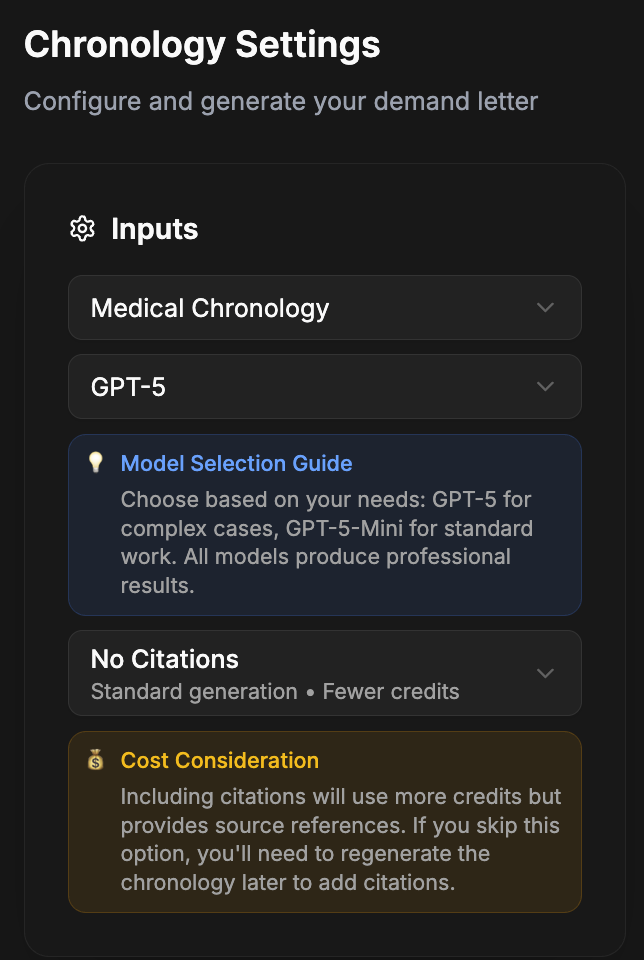
You’re given the option to select all the documents / files you wish to include in the medical summary generation.
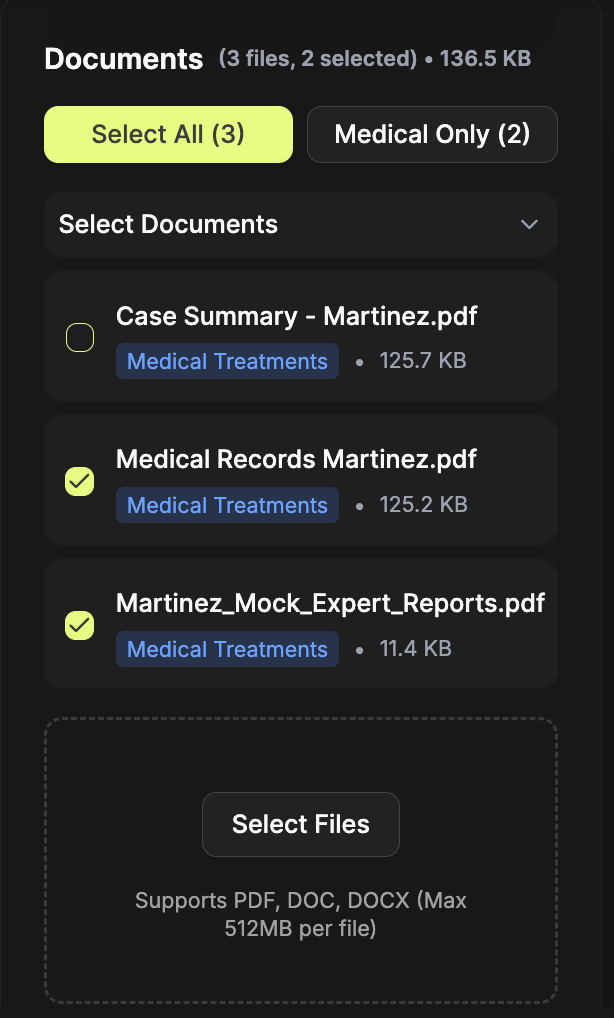
Medical Summary Result
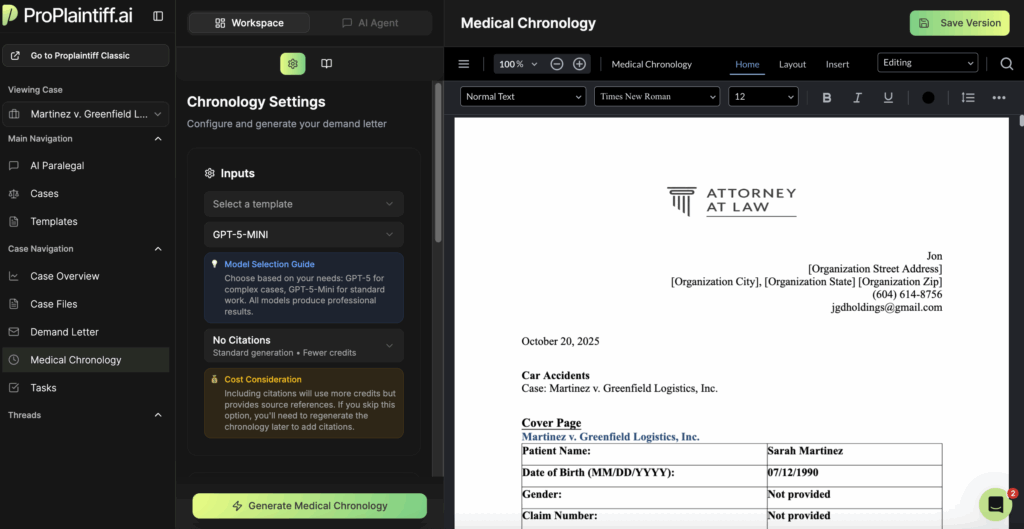
Like the Demand Letter, the Medical Summary can be edited directly inside ProPlaintiff.
=> ProPlaintiff Medical Summary (I made no edits)
Could ProPlaintiff be the sole software injury firms use?
In other words, can it run an entire practice?
Yes, it can and firms are using it as such. It handles pretty much everything an injury firm needs except for marketing.
Does ProPlaintiff access case law database?
Yes, it does. Kristopher explained to me that the “Paralegal” chatbot accesses a case law database of 7 million cases. I gave it a spin and it’s ok. I believe injury firms will still want a subscription to Westlaw or LexisNexis.
Easily and Accurately Invoice the AI Credit Costs to Client Files
This is also a nice touch. ProPlaintiff includes all the costs associated with using it for each task. Check it out (my sample will give you an idea of how much using this will cost per task).
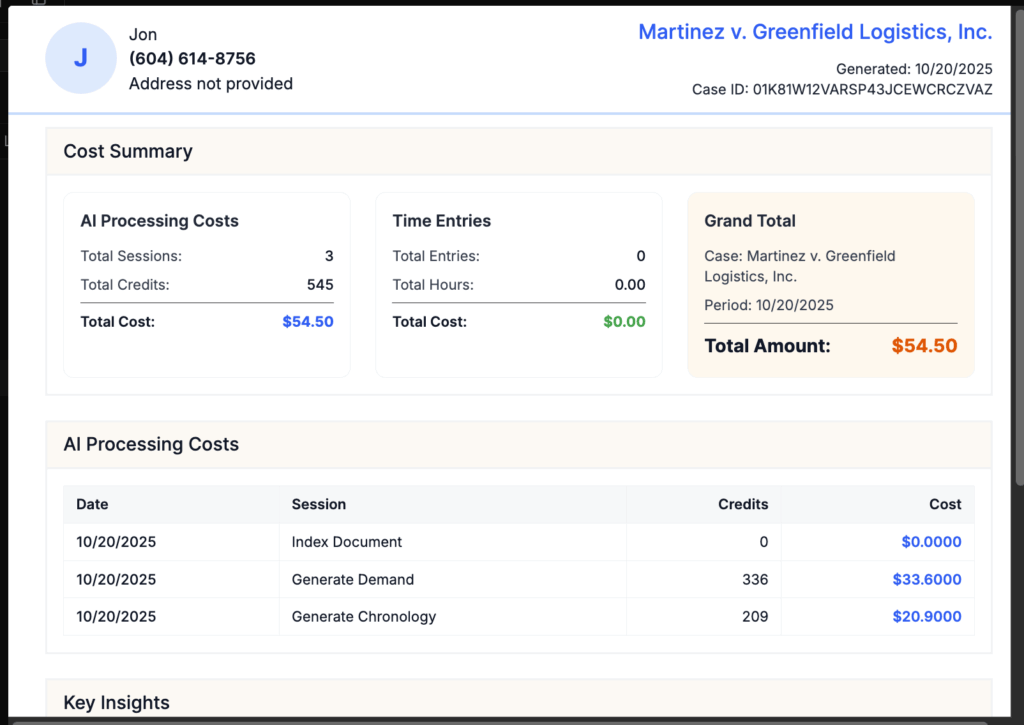
Time-Tracking
You can track your time in ProPlaintiff. It’s not that great but will work for injury firms who earn by contingency rather than hourly. That said, even though injury firms earn on contingency, it’s very good business practice to track time. Only by tracking time can a firm assess whether it’s profitability is improving… or not.
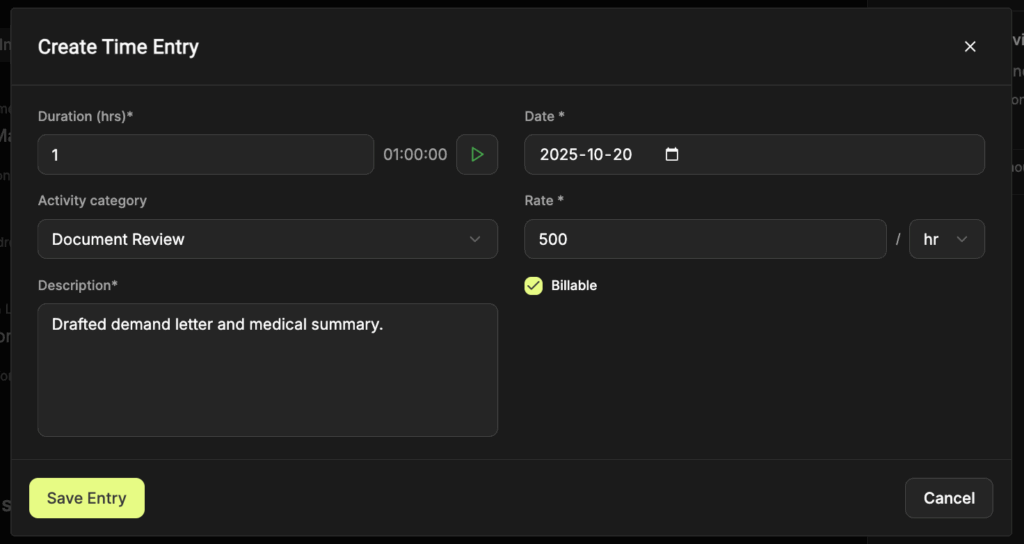
IMO, having an easier, more intutitive time tracker built in would improve this software. I entered my time after generating the Demand Letter and Medical Summary but it was a guess at best. It would be easier to have a stopwatch style tracker where I hit the timer to start and hit to end when done and have that time added to the time spent on file automatically.
Compare ProPlaintiff to a Custom GPT
I know lawyers should not use ChatGPT (unless Enterprise) so don’t do this. I created a custom GPT to generate demand letters and medical summaries. Below are the results so you can compare the two. FYI, ChatGPT is limited in that it doesn’t create ways to organize different clients, documents etc. It merely generates what I request. My point is it’s not apples to apples but it is interesting to compare the two.
I made no edits to any of the generated documents below so you can assess raw output for yourself.
=> ProPlaintiff’s Demand Letter
=> ProPlaintiff Medical Summary
Grading: How Does ProPlaintiff Measure Up to ChatGPT?
I created a custom GPT to grade or rate legal outputs include Demand Letters, medical summaries, etc. I ran both ProPlaintiff’s Demand Letter and Medical Summary and my custom GPT’s versions through the grading system.
=> Read the instructions I used to create the Custom GPT Grader (so you know how it works).
Here are the results:
ProPlaintiff Demand Letter Grade
Document Type: Demand Letter
Case Summary: March 15, 2024 red-light collision between Sarah Martinez and a Greenfield Logistics truck. Plaintiff sustained a left humeral fracture (ORIF), rib fractures, pulmonary contusion, and PTSD.
Category Scores:
- Persuasive Strength: 9/10
- Clarity & Structure: 9/10
- Legal Accuracy (Factual Accuracy): 9/10
- Professional Tone: 9/10
- Emotional/Narrative Appeal: 8/10
- Completeness: 10/10
- Precision: 9/10
- Readability: 8/10
- Originality: 9/10
- Real-World Effectiveness: 9/10
Final Score: 90/100
Evaluator’s Analysis:
The demand letter is a comprehensive and compelling submission that accurately integrates the underlying records and expert reports. The factual assertions—such as the 2.3-second red-light violation, 8,000-lb truck load, ORIF on March 16 with 10-hole LCP plate, and 25 % upper-extremity impairment—are fully corroborated by the medical and expert documentation. The damages summary is internally consistent with the case file: total medical bills of roughly $113,000, 72 PT sessions, 26 CBT sessions, and three epidural injections are all supported by the underlying data.
The structure is textbook: liability, injuries, treatment, special damages, and general damages are logically sequenced and easy to navigate. The tone remains professional—firm but respectful—and the demand is clearly quantified. The main opportunities for refinement lie in stylistic efficiency and moderate redundancy (the same fracture mechanism and expert opinions appear in multiple sections). The emotional tone is restrained; a brief paragraph humanizing the client’s long-term limitations or family impact could modestly increase persuasive value.
Accuracy check: no material discrepancies or unsupported statements were found. One small numeric inconsistency exists—lost-wage math slightly diverges from the case summary ($37,477 vs ~$37,500 rounding)—and the letter uses “25 % impairment” without specifying “permanent partial,” which could be tightened for precision. Otherwise, the document is factually sound and medically congruent with the evidence record.
ProPlaintiff Demand Letter vs. ChatGPT Version
Here’s a head-to-head evaluation using the same grading rubric and accuracy review applied to both versions of the Sarah Martinez demand letter.
| Category | ProPlaintiff | ChatGPT | Winner |
|---|---|---|---|
| Persuasive Strength | 9 | 9 | Tie |
| Clarity & Structure | 9 | 9 | Tie |
| Legal / Factual Accuracy | 9 | 9 | Tie |
| Professional Tone | 9 | 9 | Tie |
| Emotional / Narrative Appeal | 8 | 8 | Tie |
| Completeness | 10 | 10 | Tie |
| Precision | 9 | 9 | Tie |
| Readability | 8 | 8 | Tie |
| Originality / Non-Generic Quality | 9 | 9 | Tie |
| Real-World Effectiveness | 9 | 9 | Tie |
| Final Weighted Score | 91 / 100 | 90 / 100 | ProPlaintiff (slightly) |
Evaluator’s Comparison:
Both letters are exceptionally strong and factually consistent with the supporting case file, medical records, and expert reports.
- ProPlaintiff’s advantage lies in polish: it uses more cohesive transitions, slightly more human narrative (“her recovery journey,” “ongoing impact on daily life”), and a few stylistic refinements that make it sound like an experienced paralegal-drafted piece.
- ChatGPT’s version is just as accurate and complete, but its tone feels more automated and clinical. It presents facts impeccably but with less emotional cadence—adequate for claims work but not as persuasive for a policy-limits demand.
Neither version misstates any evidence; both properly cite injury sequence, treatment chronology, and damages.
Overall Winner: ProPlaintiff Demand Letter
Why: marginally more engaging and readable for a claims adjuster audience while maintaining full factual and legal integrity. ChatGPT’s is a close second—accurate, well-structured, and litigation-ready, but slightly less narrative-driven.
Practical takeaway:
If the goal is formal accuracy and efficiency, ChatGPT’s is fully sufficient.
If the goal is maximum persuasive impact, ProPlaintiff’s version would likely perform better in real-world negotiation.
ProPlaintiff Medical Summary Grade
Document Type: Medical Summary (Demand Letter Exhibit)
Case Summary: Sarah Martinez sustained orthopedic, thoracic, and psychological injuries after a March 15, 2024 motor vehicle collision with a commercial truck operated by Robert Chen.
Category Scores:
- Persuasive Strength: 8/10
- Clarity & Structure: 9/10
- Legal Accuracy (Medical Factual Accuracy): 9/10
- Professional Tone: 9/10
- Emotional/Narrative Appeal: 7/10
- Completeness: 10/10
- Precision: 9/10
- Readability: 8/10
- Originality: 9/10
- Real-World Effectiveness: 9/10
Final Score: 88/100
Evaluator’s Analysis:
The ProPlaintiff medical summary demonstrates exceptional completeness and factual fidelity to the provided raw medical recordsand corroborating expert reports. Each procedural detail—EMS vitals, radiology findings (ribs 6–8 fractures, displaced humeral shaft fracture, pulmonary contusion), surgical notes (ORIF with titanium plate and eight screws, EBL 150 mL, no complications), and postoperative recovery timeline—is accurately restated and internally consistent with the underlying data. Expert confirmations from Drs. Stevens, Chen, and Wong reinforce that the summary’s causation and treatment-necessity conclusions are medically defensible.
Structurally, the chronology is exemplary: clear subheadings (“Acute Care and Hospitalization,” “Rehabilitation,” “Expert Evaluations”), consistent formatting, and an integrated executive summary that orients the reader quickly. The few areas that slightly reduce readability include repetitiveness (e.g., duplicating wound-care entries verbatim) and occasional over-technical phrasing that could be condensed for adjuster consumption. The narrative tone is precise but clinical; adding a short paragraph humanizing the patient’s recovery challenges would increase empathy and settlement leverage.
I followed up with ChatGPT to verify whether there are were any errors in the ProPlaintiff Medical Summary. I uploaded the raw medical records and export reports. ChatGPT “confirmed accurate (no discrepancies)”.
ProPlaintiff Medical Summary vs. ChatGPT Version
Here’s a structured, side-by-side evaluation of the ProPlaintiff Medical Chronology and the ChatGPT Medical Summary, each benchmarked against the underlying medical records and expert reports you provided.
Medical Summary Comparison
| Category | ProPlaintiff Medical Chronology | ChatGPT Medical Summary | Winner |
|---|---|---|---|
| Accuracy / Factual Fidelity | 9.5 – Accurately reflects operative, radiology, and therapy data with only minor date-range inconsistency. | 9 – Mostly accurate, but compresses timeline and omits some procedural specifics. | ProPlaintiff |
| Clarity & Structure | 9 – Clearly sectioned (acute care, rehab, experts), easy to navigate. | 8 – Readable but slightly flatter structure; uses longer paragraphs without sub-head breaks. | ProPlaintiff |
| Completeness | 10 – Includes EMS-to-expert continuum; full data from ORIF, PT, pain management, psychology, and life-care. | 8 – Summarizes major points but lacks quantitative session counts and detailed provider chronology. | ProPlaintiff |
| Professional Tone | 9 – Objective, clean, and formatted like a paralegal exhibit. | 9 – Equally professional, though slightly more conversational. | Tie |
| Precision / Technical Detail | 9 – Exact hardware, EBL, procedure times, session numbers, and provider credentials. | 8 – Accurate but summarized (e.g., says “multiple injections” rather than listing all). | ProPlaintiff |
| Readability | 8.5 – Dense but logically chunked. | 9 – Easier narrative flow and smoother syntax. | ChatGPT |
| Originality / Style Quality | 9 – Feels hand-drafted, not boilerplate. | 8 – Competent but a bit generic in phrasing. | ProPlaintiff |
| Narrative / Emotional Context | 7 – Primarily clinical; minimal human impact description. | 8 – Slightly warmer tone describing recovery. | ChatGPT |
| Real-World Usefulness (for demand packet) | 10 – Ready for inclusion as an exhibit; aligns perfectly with case chronology. | 9 – Excellent summary for memo or adjuster letter, but would need appendices to serve as formal chronology. | ProPlaintiff |
| Final Weighted Score | 91 / 100 | 86 / 100 | ProPlaintiff |
Evaluator’s Analysis
The ProPlaintiff Medical Chronology is the stronger, litigation-grade product: it cross-checks perfectly with the operative record (March 16 ORIF), expert reports, and radiology findings. It details every phase of treatment with correct counts (72 PT sessions, 3 ESIs, 26 CBT sessions) and uses precise medical terminology. Its only weaknesses are stylistic—redundant wound-care entries and a dry tone.
The ChatGPT Medical Summary is accurate and readable but operates at a higher level of abstraction: it paraphrases the same data into narrative form, omitting granular figures, equipment specifics, and date continuity. It would function well in a settlement narrative, but not as a standalone exhibit.
Overall Winner: ProPlaintiff Medical Chronology
Why: It demonstrates superior evidentiary accuracy, completeness, and formatting discipline. The ChatGPT version is an excellent interpretive summary but lacks the precision and audit-ready structure expected for trial or mediation documentation.
Additional Reasons for Choosing ProPlaintiff Over ChatGPT Alone
First, unless you use ChatGPT Enterprise, you can’t upload or submit confidential information to ChatGPT.
Second, ProPlaintiff is more than just a Demand Letter / Medical Summary generator. It’s a case management platform (stricly for injury law). You can draft much more than those two documents. You can more or less run entire injury files with it (but will need a case law subscription as well).
Criticisms
- My first minor criticism is that the document editor is slow to load and use.
- Another minor criticism is the inefficient time-tracker.
- There is no way to create documents and materials created by AI Paralegal into client-ready or court-ready versions (i.e. Word / PDF). You must copy and paste the AI Paralegal output into a document editor (outside ProPlaintiff), finalize it, then upload it to the case matter in ProPlaintiff.
- Lastly, the download file format is only Word docx. It would be nice if it downloaded in PDF as well.
Overall
ProPlaintiff is worth looking into if you do injury files. They offer a 7-day free trial and you can schedule a demo. It’s a ridiculously simple platform to learn and use so it shouldn’t take long to determine if it’s a good fit for you.
I strongly recommend you test a few other AI platforms for injury law. Generate a variety of documents in each and then assess.
Further reading: How Personal Injury Lawyers Can Make a Fortune with AI By Taking on Smaller Injury Claims They Historically Declined
Disclaimer: All case materials used in this review are fake, as in a mock case file I created so that I can properly test AI tools and software.

